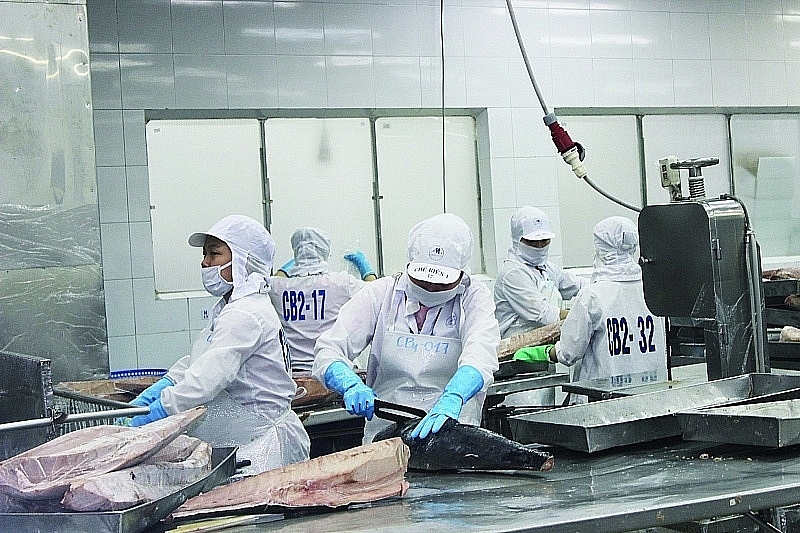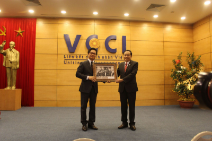Export moves to Halal markets
The recent implementation of free trade agreements (FTAs) has brought many tax incentives and reduced procedures for exporting Vietnamese goods to Muslim markets. With this advantage, export enterprises are moving their direction and taking advantage of the opportunity to bring goods to this potential market.
 |
|
Binh Dinh Seafood Joint Stock Company is moving its export to the Halal market. Photo: T.H |
Efforts to achieve Halal standards
Successfully exporting to Muslim markets (Halal) for many years, Ms. Cao Thi Kim Lan, Director of Binh Dinh Seafood Joint Stock Company, said that in recent years, the company's tuna export to the EU had been affected by the IUU yellow card, so the company diversified its markets, moving export to Halal markets, with orders increasing day by day. “Currently, our products have met the standards, achieved Halal certification and food hygiene and safety certification, and are being promoted for export to the Middle East market, especially the United Arab Emirates (UAE)” - Ms. Lan shared.
According to Ms. Lan’s experience, to enter the Halal market, Halal certification is required. Muslim countries account for 1/3 of the world’s population. Muslims are willing to pay higher prices for green, clean products with Halal certification. Enterprises need to meet these criteria for sustainable export.
Previously, Vietnamese products entering the Muslim market had to pay import tax. Recently, free trade agreements (FTAs) have brought many tax incentives and reduced procedures for exporting Vietnamese products with Halal certification. Therefore, Vietnamese enterprises need to take advantage of this opportunity.
Notably, during his recent official visit to the UAE, Prime Minister Pham Minh Chinh and senior UAE leaders witnessed the signing ceremony of the Vietnam-UAE Comprehensive Economic Partnership Agreement (CEPA) between Vietnam and the UAE. Thus, CEPA was signed after just over a year of negotiations. This is the first free trade agreement that Vietnam has signed with an Arab country, opening a new era in the upgraded and increasingly substantive relationship between Vietnam and the UAE in particular and Arab countries in general.
Notably, the two sides have agreed to make a strong commitment to trade liberalization, with the UAE committing to phase out tariffs on 99% of Vietnam’s exports to the UAE on route. The agreement also includes many provisions to facilitate trade and investment, in line with current trends in digital transformation and green development.
With its strategic geographical location, logistics system, and modern seaport infrastructure, the UAE is an important gateway and can facilitate Vietnamese goods to access and expand to the Middle East, Africa, and Europe markets. Furthermore, with a growing population, high income, rapid urbanization, rising disposable income, and a preference for seafood protein among young people, online searches for seafood products have increased in recent years, which is expected to boost seafood consumption in the region.
According to Ms. Kim Thu, a shrimp expert from the Vietnam Association of Seafood Exporters and Producers (VASEP), in the UAE market, Vietnamese shrimp must compete with Indian, Chinese, and Ecuadorian shrimp. Of which, Indian shrimp accounts for nearly 60%-70% of the market share, Ecuador has only penetrated the market in recent years with a 15% market share, while Vietnamese shrimp only accounts for about 5%-7% of the market share. It is expected that with the newly signed CEPA Agreement, Vietnamese shrimp will enjoy the highest and earliest tax incentives, in order to increase its market share in this market.
Currently, tuna products imported into the UAE are subject to a 5% tax rate. Therefore, enterprises expect to expand this market further when the FTA between Vietnam and the UAE takes effect and reduces the import tax on seafood to 0%. This will increase the competitiveness of Vietnamese tuna products in this market.
Besides tariffs, the biggest difficulty for enterprises exporting to the UAE is the importer's requirements related to Halal certification. Accordingly, the product must not contain any ingredients prohibited by Islamic law; during all stages of production, the product must not come into contact with any means or equipment made from materials that are not permitted by Islamic law; and during the process, the product must not come into contact with any nutritious food made from ingredients that are not accepted by Islamic law. Enterprises are concerned about overcoming this issue.
Opportunities from a trillion-dollar market
As one of the units actively supporting enterprises to access new markets, Mr. Dao Minh Chanh, Deputy Director of the Ho Chi Minh City Investment Promotion Center (ITPC), said that the Halal industry was growing strongly with more than 2 billion Muslims worldwide. Establishing Halal standards from production to distribution was becoming an important trend, creating great opportunities for Vietnamese enterprises. The scale of the global Halal economy reached more than US$D 7,000 billion in 2024, expected to increase to about US$ 10,000 billion before 2028. The total number of Muslims in 2024 was about 2.2 billion people, expected to reach 2.8 billion people (30% of the world's population) by 2030, doubling the population growth rate of other religions.
Accordingly, the Halal industry is forecast to continue to grow strongly in the Asian, Middle Eastern and African markets. Halal trends in 2024 will contribute to reshaping the global Halal business environment, creating new opportunities but also requiring enterprises to quickly adapt to the new context.
With the trend of building a Halal value chain, the Halal market is shifting from a mindset of only caring about Halal products to building the entire Halal supply chain.
For sustainable export, it is necessary to focus on establishing Halal standards. Accordingly, enterprises and manufacturers need to set specific criteria in the Halal production process including factors such as the number of complaints, Halal incidents, inspection frequency, the rate of trained employees, the level of Halal maturity, Halal trust, Halal reputation index, operating license and Halal rating.
Enterprises and suppliers also need to build a reputable Halal brand based on product quality and the quality of the entire Halal business value chain, develop a practical roadmap to deploy the Halal value chain and review progress.
Mr. Firdauz Bin Othman, Consul General of Malaysia in Ho Chi Minh City, said that Halal standards had been accepted globally, especially in terms of food hygiene and safety. This has contributed positively to the development and increased demand for Halal products. The Halal food sector is growing at a very fast pace, forecast to reach a value of about US$ 4.5 trillion by 2030. This market is growing due to the growth of the global Muslim population as well as the demand for Halal-certified products. This has brought great opportunities for many countries including Vietnam to proactively approach the Halal market.








